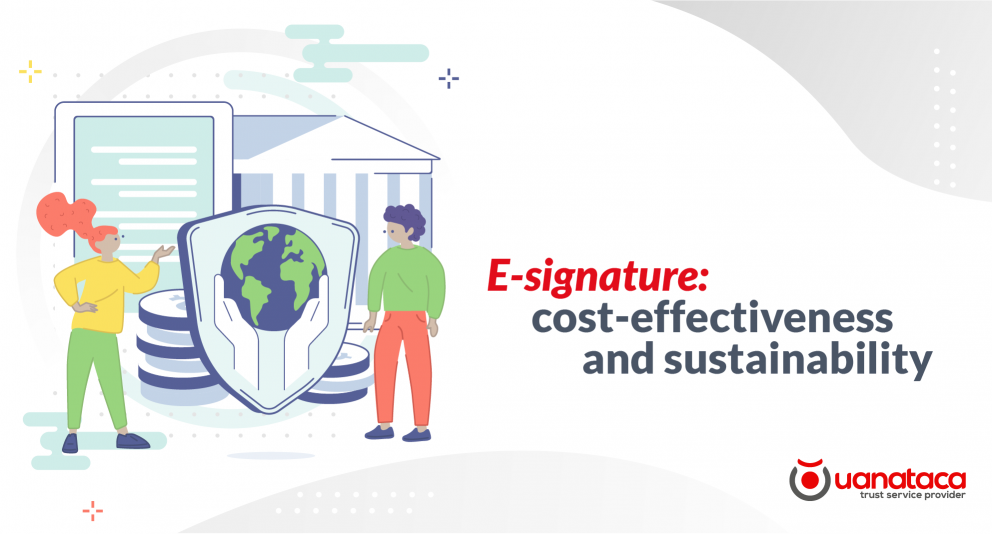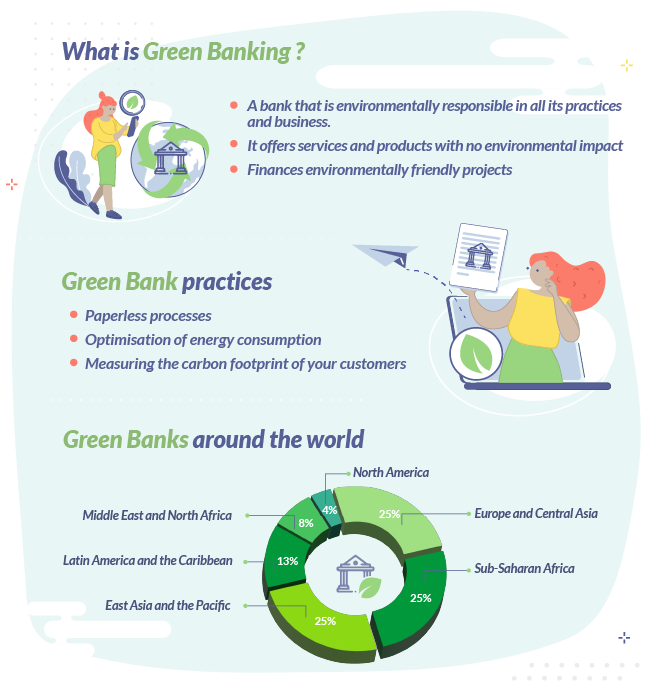
The world of retail and commercial banking, a complex and fast-moving sector, has undergone major disruptive changes resulting from COVID-19. The new banking business model is characterized by a migration from offices to the digital plane: a new banking willing to offer innovative services and unique digital experiences in a context of commitment to environmental care.
In this article we discuss the concept of green banking, its fundamental principles and how e-signatures promote responsible practices within corporate processes.
What is green banking and what are its benefits?
DEFINITION: The concept of green banking is the result of environmental commitment. Green banks are those entities that seek profitability while respecting fundamental principles that guarantee a positive environmental impact.
Less than five years ago, few people were talking about sustainable finance. Generally, it was believed that the industries that needed to change the most in order to contribute to environmental protection were those considered the most polluting: the fashion, automobile and energy industries. However, the banking sector's adherence to a more sustainable business model creates potential energy and synergies in the environmental struggle.
The opportunity to become a green bank is integral and transversal in banks, impacting all customer segments and those aspects related to efficiency, productivity and the positive perception of customers and society in general.
Benefits of green banking
- Improved operational efficiency
- Appropriate risk management and mitigation with risk-adjusted profitability
- Innovative customer growth
- Improved reputation through better alignment with the overall interests of the country and the communities the banks serve.
Fundamental principles of green banking
Experts agree on the need to undertake a change of model and move from 'business as usual' to a Green Business Model.
This new business model, respectful of the environment, seeks profitability but under some fundamental principles in its identity and activity that favor the care of the planet and the welfare of people:
1. Eco-efficiency within the bank itself and throughout its value chain with suppliers, customers, among others.
2. The provision to customers of a green portfolio with an offer of green products and services.
3. The existence of a strategy and culture that provides corporate vision and resources to the above principles.

The green portfolio: green financial products and services
Aware of the global benefits of adopting a green banking model, the financial industry is betting on green and social finance. For this reason, they are designing a range of sustainable products that contribute to mitigating the impact of climate change.
What is a green banking product/service? These are traditional banking products that are redefined, incorporating a positive and quantifiable environmental impact. Some examples of green financial products in favor of the planet are:
> Green mortgages
> Energy efficiency loans
> Low-carbon agriculture loans
> Clean transportation loans and leases Loans
The future of banking is green
The global financial world is mobilizing to support the transition to a green economy. During the last international summit on climate change - the so-called COP26 - held in Glasgow, 450 financial institutions from 45 different countries announced their intention to achieve zero emissions in their lending.
Thanks to the partnership between UN Ambassador Michael Bloomberg and the financial sector, the major banks have committed to invest 130 billion euros to finance investments associated with the green transition until 2050. This means that over the coming decades, large banking companies will allocate these funds to viable and profitable projects and investments and in turn, greatly reduce financing for coal and other polluting economic activities.
Major international companies such as BBVA, for example, have announced their intention to reduce the carbon intensity of their lending portfolio by 52% in electricity generation; 46% in automobile manufacturing; 23% in steel production; and 17% in cement production. These targets are in addition to its goal to stop financing coal by 2030 in developed countries and by 2040 in the rest.
In this transition to more sustainable finance, the widening inequality gap between rich and poor countries is one of the main challenges. The solution would be so-called blended finance, or mixed finance, in which public and private capital complement each other for projects in developing countries. It will be the World Bank, together with the regional development banks, who will identify and validate those projects that are in line with national emission reduction commitments.
The electronic signature as a key tool in green banking
In this post we have talked about the need for a strategy and culture that provides corporate vision and resources to achieve the fundamental principles of green banking. This is the only way to promote responsible practices within corporate processes, such as paperless banking, the optimization of energy consumption or the measurement of the carbon footprint of the bank's customers.
The implementation of electronic signatures plays an important and, in some cases, decisive role in the fulfillment of the fundamental principles, both those that are acquired with the people who make up the organization, with customers, stakeholders and with the environment.
Environmental social responsibility: paperless processes 🌍 🌱 🌱.
Traditionally, the banking sector has used large quantities of paper in its physical offices for most procedures and formalities, including its internal communications or periodic information sent by post to customers. Reducing the environmental impact of this excessive paper consumption is one of the main objectives of green banking.

Uanataca's paperless solutions are environmentally friendly and, in the case of qualified electronic signatures, have the same legal effect as handwritten signatures. It also brings a number of benefits that justify eliminating or reducing paper consumption:
- Cost reduction: depapelization significantly reduces numerous costs associated with printing paper, its handling and mailing, and its physical archiving. After conducting several surveys, the Association for Information and Image Management (AIIM) established that 84% of companies with paperless processes had significantly increased their ROI.
- Improves reputation: a paperless office is a statement of intent, a commitment to employees, customers and society in general.
- Increased productivity: repetitive, time-consuming and repetitive tasks are eliminated, freeing up resources for more productive tasks.
In conclusion, climate change is a global and growing concern that has become a disruptive factor in the business world. In banking and the financial sector in general, the disruption is greater because of the variety and depth of stakeholders that are affected by its reaction to climate change.
Most of the banking processes as well as its financial products and services can be green. In this transformation, the electronic signature becomes a key resource to achieve a balance between profitability and commitment to the care of the planet and the well-being of people.
